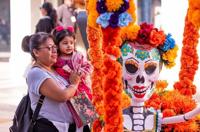
"Frida Kahlo's Flower Crown" picture book cover.
Nydia Armendia-Sánchez’s new picture book, "Frida Kahlo’s Flower Crown," is a vibrant tribute to resilience and the enduring power of Latino heritage.
With captivating illustrations by Pura Belpré award winner Loris Lora, the story invites readers to reconnect with the gifts of nature, just as Frida did. Surrounded by “Señor Xolotl”, her loyal Xoloitzcuintli dog, or wearing her iconic flower crowns, the story is deeply rooted in the rich traditions of Tehuana culture.
For Armendia-Sánchez’s, becoming a writer wasn’t part of the plan. Growing up as a first-generation American with roots in Guatemala and Spain's Basque Country, she never imagined authorship was even an option.
“I never even thought being an author or a writer was something that I could do, like it was not on my radar. It was not something that when I was a kid, I was like, ‘Oh, I could be an author.” I don't know, maybe because I never saw [in publishing] anyone that looked like me, sounded like me,” she explained. “It was really, after I had my kids […] that I was looking for books. Couldn't find anything. I started just writing stories for them, […] about our heritage, things that I wanted to pass on to them. And I really started to enjoy the process.”
Lora shares a similar story. As a first-generation Mexican American with parents from Hidalgo, Mexico, she, too, lacked representation in the books she read as a child. “You don't see a lot of representation in children's books,” she says. “Working on Latino/Latina books are just so much fun because I'm able to put a lot more of myself into them.”
Their book celebrates the vibrant floral headpieces that became synonymous with Frida Kahlo’s self-expression, but at its heart, it’s a personal project. One that ties back to their identities, their families and the invisible threads of heritage woven through their lives.
Celebrating Mexican native plants

"Frida Kahlo’s Flower Crown" author Nydia Armendia-Sánchez.
For Nydia, writing is an organic, almost instinctive process. “Most of the time, when I have a new project, it seems to pour out. Like three-quarters of it will just kind of pour out. I don't think about beginning, middle, end. That's not how my brain works. I'm like, ‘Oh, this would be an interesting story, let me just start writing,’” she says. For her, the story is the priority. Research will come later.
In the case of this book, when that time arrived, examining Frida’s life proved to be an eye-opening experience. As she learned more about the painter's personal struggles, especially her battles with illness, she gained a deeper appreciation for her resilience.
Still, the author acknowledges that Frida will always remain somewhat of a mystery, noting that even reading Frida’s diary doesn’t offer a complete picture. That lingering mystery, she reflected, is part of what continues to make Frida so compelling.
One of the heartbeats of “Frida Kahlo’s Flower Crown” lies in its vivid portrayal of plants and flowers—not just as decoration, but as symbols of cultural pride and ecological awareness. For Armendia-Sánchez and Lora, it was essential to spotlight Mexico’s native flora, including depictions of organ pipe cactus, agave and cypress, honoring Frida’s deep connection to her heritage. But beyond celebrating Frida’s world, the book invites readers to look closer to home.
“We also wanted to show readers the importance of uplifting the native plants in your own area so that […] future generations can preserve those plants,” said the writer.
These insights into Frida’s life are not just historical facts but sources of inspiration for her. They echo the very messages she hopes readers will take from the book: self-empowerment, self-love and a curiosity about one’s own roots. Whether it's exploring the local flora and fauna or embracing cultural heritage, she emphasizes the importance of being unapologetically yourself, “wearing your crown.”
For Lora, another central element was to create the illustration using analog materials, such as paint on paper, rather than digital ones. “It was my way of kind of honoring Frida as a painter. I was like ‘It needs to be painted,’ because Frida would have painted something like this,” she said.
The illustrator hopes her work will spark curiosity and inspire children to pursue their artistic dreams. “I want them to hopefully feel inspired and be like […] you can paint this,” she says, envisioning young readers seeing their own potential reflected in the pages.
The urgent need for Latinx representation

Illustrator Loris Lora.
Their book enters a publishing landscape where Latinx stories remain painfully scarce. Walk into most bookstores, and you’ll notice the imbalance: shelves overflowing with books, but Latinx authors struggling for visibility.
The numbers tell the story. According to the 2023 Lee and Low Diversity Baseline Survey, just 4.6% of publishing professionals identify as Latinx—this, in a country where Latinos represent 19% of the population. The disconnect is glaring, underscoring the significant work that remains to be done in elevating Latinx voices in the literary world.
Both creators see their book as part of a larger movement to amplify underrepresented voices. For Armendia-Sánchez, every story she writes is layered with heritage, out of a desire to see her community reflected with depth and nuance. For Lora, every illustration is an opportunity to leave a visual legacy that honors her roots.
“I think creating and putting stuff out there is probably, like, one of the biggest forms of bravery,” Nydia reflects, “because you're showing the vulnerable side of you.” In today’s charged political climate, that bravery feels even more necessary. For Latino creators, sharing their stories isn’t just personal—it’s a form of resistance against being reduced to statistics or negative stereotypes. Their work reminds us that Latinos are a richly diverse community that has long shaped and contributed to the fabric of U.S. society—a fact woven into the country's history, though often overlooked or forgotten.
As they look to the future, their hope is simple yet profound: that their book will inspire children to embrace their identities with pride, curiosity and creativity.
With every flower crown they paint and every page they write, they are doing just that.















(0) comments
Welcome to the discussion.
Log In
Keep it Clean. Please avoid obscene, vulgar, lewd, racist or sexually-oriented language.
PLEASE TURN OFF YOUR CAPS LOCK.
Don't Threaten. Threats of harming another person will not be tolerated.
Be Truthful. Don't knowingly lie about anyone or anything.
Be Nice. No racism, sexism or any sort of -ism that is degrading to another person.
Be Proactive. Use the 'Report' link on each comment to let us know of abusive posts.
Share with Us. We'd love to hear eyewitness accounts, the history behind an article.